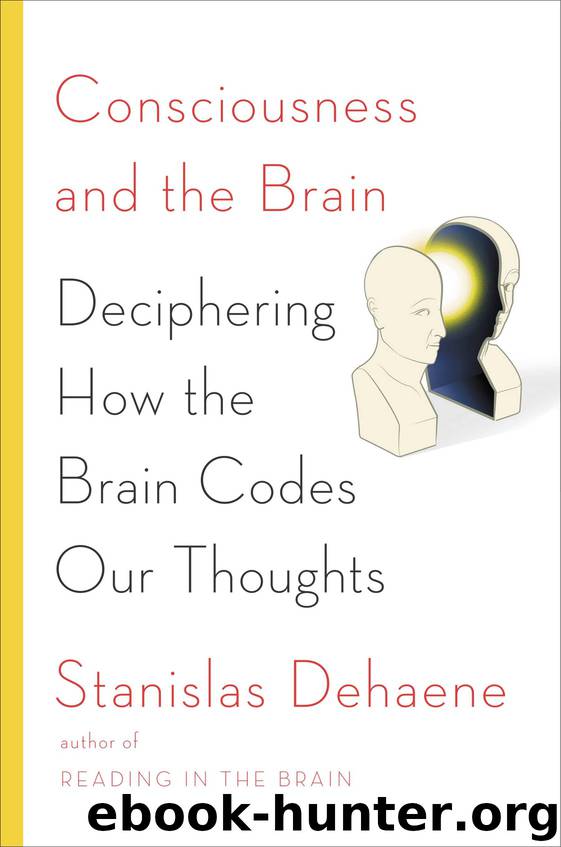Consciousness and the Brain by Stanislas Dehaene

Author:Stanislas Dehaene
Language: eng
Format: epub, mobi
Publisher: Penguin Group US
Published: 2014-01-29T16:00:00+00:00
The Restless Brain
I tell you: one must still have chaos in one, to give birth to a dancing star. I tell you: ye have still chaos in you.
—Friedrich Nietzsche, Thus Spoke Zarathustra (1883–85)
Another fascinating phenomenon emerged in our simulation: spontaneous neuronal activity. We did not have to constantly stimulate our network. Even in the absence of any input, neurons would spontaneously fire, triggered by random events at their synapses—and this chaotic activity self-organized into recognizable patterns.
At high levels of the vigilance parameter, complex patterns of firing continuously waxed and waned on our computer screens. Within them, we occasionally recognized a global ignition—triggered in the absence of any stimulus. An entire set of cortical columns, all coding for the same stimulus, would activate for a short period, then fade away. A fraction of a second later, another global assembly would replace it. Without any cueing, the network self-organized into a series of random ignitions, closely resembling those evoked during the perception of external stimuli. The only difference was that spontaneous activity tended to start at the higher cortical levels, within workspace areas, and to propagate downward into the sensory regions—the converse of what happened during perception.
Do such bouts of endogenous activity exist in the real brain? Yes. In fact, organized spontaneous activity is omnipresent in the nervous system. Anyone who has ever seen an EEG knows this: the two hemispheres constantly generate massive high-frequency electrical waves, whether the person is awake or asleep. This spontaneous excitation is so intense that it dominates the landscape of brain activity. By comparison, the activation evoked by an external stimulus is barely detectable, and much averaging is needed before it can be observed. Stimulus-evoked activity accounts for only a very small amount of the total energy consumed by the brain, probably less than 5 percent. The nervous system primarily acts as an autonomous device that generates its own thought patterns. Even in the dark, while we rest and “think of nothing,” our brain constantly produces complex and ceaselessly changing arrays of neuronal activity.
Organized patterns of spontaneous cortical activity were first observed in animals. Using voltage-sensitive dyes, which transform invisible voltages into visible changes in light reflectance, Amiram Grinvald and his colleagues at the Weizmann Institute recorded the electrical activity of a large patch of cortex for an extended period of time.49 Fascinatingly, even though the animal was anesthetized, complex patterns emerged. In the dark, without any stimulation, a visual neuron would suddenly start to discharge at a higher rate. It was not alone: imaging showed that, at the very same moment, a whole assembly of neurons had spontaneously activated.
A similar phenomenon exists in the human brain.50 Images of brain activation during quiet rest revealed that, far from remaining silent, the human brain exhibits constantly changing patterns of cortical activity. Global networks, often distributed across the two hemispheres, activate similarly in different people. Some of them correspond tightly to the patterns evoked by an external stimulation. For instance, a large subset of the language circuit activates
Download
Consciousness and the Brain by Stanislas Dehaene.mobi
This site does not store any files on its server. We only index and link to content provided by other sites. Please contact the content providers to delete copyright contents if any and email us, we'll remove relevant links or contents immediately.
| Anatomy | Animals |
| Bacteriology | Biochemistry |
| Bioelectricity | Bioinformatics |
| Biology | Biophysics |
| Biotechnology | Botany |
| Ecology | Genetics |
| Paleontology | Plants |
| Taxonomic Classification | Zoology |
Sapiens: A Brief History of Humankind by Yuval Noah Harari(14258)
The Tidewater Tales by John Barth(12610)
Mastermind: How to Think Like Sherlock Holmes by Maria Konnikova(7235)
Do No Harm Stories of Life, Death and Brain Surgery by Henry Marsh(6891)
The Thirst by Nesbo Jo(6838)
Why We Sleep: Unlocking the Power of Sleep and Dreams by Matthew Walker(6620)
Life 3.0: Being Human in the Age of Artificial Intelligence by Tegmark Max(5480)
Sapiens by Yuval Noah Harari(5298)
The Longevity Diet by Valter Longo(5021)
The Body: A Guide for Occupants by Bill Bryson(4979)
The Rules Do Not Apply by Ariel Levy(4870)
The Immortal Life of Henrietta Lacks by Rebecca Skloot(4529)
Animal Frequency by Melissa Alvarez(4400)
Why We Sleep by Matthew Walker(4366)
The Hacking of the American Mind by Robert H. Lustig(4319)
Yoga Anatomy by Kaminoff Leslie(4310)
All Creatures Great and Small by James Herriot(4239)
Double Down (Diary of a Wimpy Kid Book 11) by Jeff Kinney(4210)
Embedded Programming with Modern C++ Cookbook by Igor Viarheichyk(4112)
